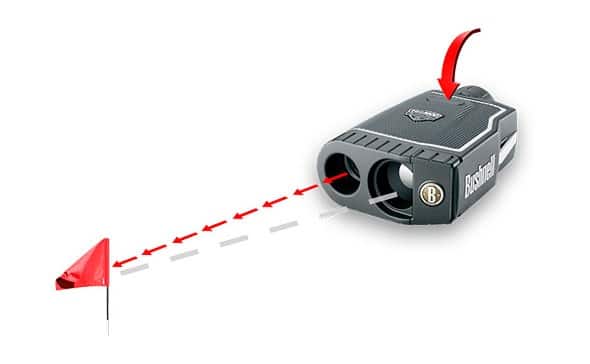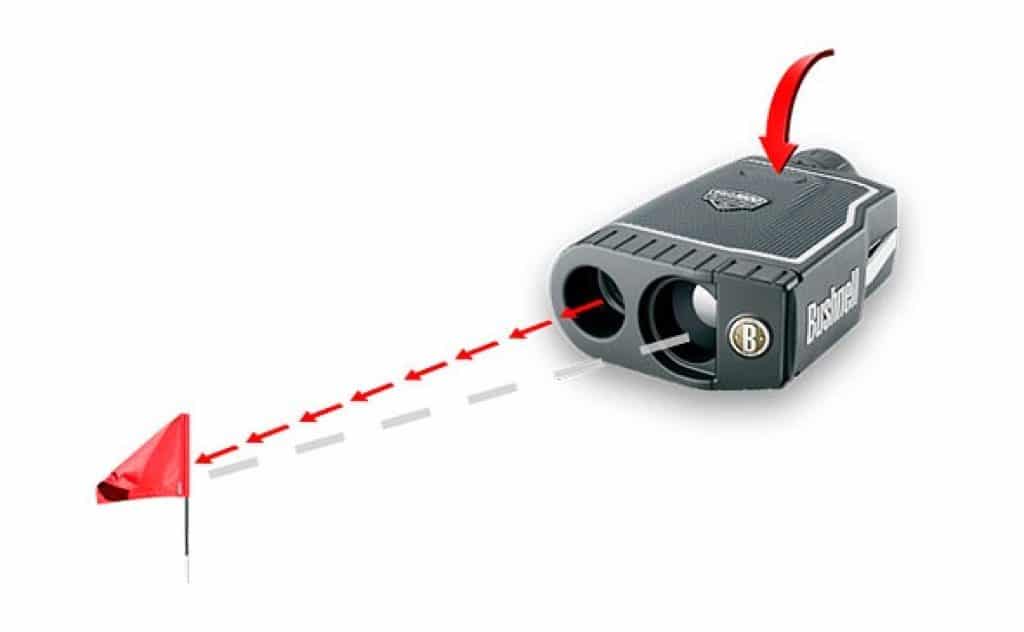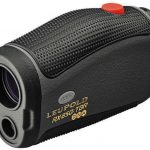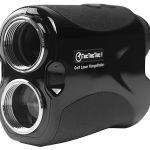
Are you a nonchalant elated rangefinder user who never found out how it works? Perhaps you’re not; you’ve consistently been asking yourself rhetorically ‘how do laser rangefinders work?’ but never got an answer. Here is the article that’s designed to help you. This article doesn’t base its facts on a product but it covers the performance of laser rangefinders in all ramifications.
Let’s begin by finding out what rangefinders is all about. Rangefinders are detecting devices. They are primarily used for determining the distance apart between the user and the intended target.
Furthermore, there are three types of rangefinders that are presently available. They are laser rangefinders, ultrasonic rangefinders, and optical rangefinders. However, we’ll be discussing laser rangefinders. This is because the laser rangefinder is the most dependable among the three due to the fact that it utilizes electromagnetic waves to carry out its mechanism.
Unlike the ultrasonic rangefinders that use sound waves, laser rangefinders transmit data at the rate of speed of light which is accurate and reliable. In other words, simply because the time it takes returning light is short, it’s very easy to use them for determining moving objects which is a wide difference between this type of rangefinder and the others.
Laser rangefinders utilize optical remote sensors to locate an intended target. The remote sensor is also known as the Light Detection and Ranging (LIDAR) technology. This technology also consists of angular or spatial resolution power which makes it possible for users to vividly see the graphics display of the object in their sizes and produce the distance apart in yardage.
I guess it’s hard to comprehend, right? Therefore, let’s break down the mechanism by giving it a systematic approach.
8 Things to Consider about ‘How do Laser Rangefinder Work?’
Electronic Device
Laser rangefinders are electronic detecting devices. In other words, they are gadgets that make use of either replaceable or irreplaceable batteries. They can be switched on and off. In fact, they display their information on screens with real images. Unlike several others, due to the fact that they make use of silicon chips, they process their information speedily and accurately. They are small in spite of their numerous functions and they are reliable.
Beam Divergence
Laser rangefinders disperse beams of light via the optical aperture. The collection of rays that are dispersed diverge until they detect the intended target. Then, once the intended target is trapped/pin, the dispersed beam of lights then travel back in form of reflections but they are now received into the optical receiver aperture where the reflection is detected by the photodiode.
The beam of light that it emits is short-wave infrared rays. This gadget is able to capture the images due to their reflection power of nature. In other words, most laser rangefinders become very accurate in fair weather because of the reflective power of the ecosystem which doesn’t tamper with the beam divergences.
Spotting of Targets
We mentioned earlier that laser rangefinders use the Light Detection and Ranging (LIDAR) technology which is the major bonus for its mechanism. This technology consists of angular resolution which it uses in focusing a target as the beam diverges from the optical aperture. The focus at the pulses helps the sensors to readout/pin down the distance of the target by calculating the time of the returned beam. In other words, targets are trapped when the light is steady/fixed to a particular spot.
Nevertheless, it’s no doubt that laser rangefinders that with large size optical aperture tend to use longer-wave infrared rays which enable them to see longer range distance and shorter-range distance than laser ranger with small size optical aperture.
Possible Affecting Factors
Of course, atmospheric changes do affect the accuracy of rangefinders. Factors that affect it are:
- Fogs and mists
- Rainfalls.
- Wind.
- Darkness
- Battery failure.
- Snow
These factors are capable to affect the light pulse. And this may cause the miscalculation of the time of flight while sending the data to the sensor. Nevertheless, modern laser rangefinders are designed with enough capacity to receive several echoes from one laser beam. In fact, their eyecups are coated with thick weatherproof materials so as to prevent them from making miscalculations.
Calculations
Just as we discussed, the laser rangefinder utilizes ‘Time of Flight’ to make its calculation. The ultimate thing you must know is that the wave that is emitted by the optical aperture are coded pulses. So, the time and the speed of the reflected pulses are calculated by the sensor as soon as it’s received at the receiver optical aperture. And the calculated time and speed are converted to distance, it then displays the result in units. Of course, because it uses coded pulses it’s very easy for the photodiode in the receiving optical aperture to trap the pulses.
Triangulation is imbibing the trigonometry principle in calculating the average time traveled. How does this work? The emitted photons are exchanged from both the optical aperture and the receiver optical aperture. The pulses/photon/infrared beam emitted from the optical aperture travels until it hits the target, then the returning photon returns to the receiver optical aperture. However, an imaginary line is formed from the position of the intended target to the center of the triangular photons, resulting in two right-angle triangles. This is what produces the calculation on STRAIGHT-LINE DISTANCE MODE.
However, it doesn’t work the same way for hunters, shooters, and some others, why? This is because it’s done in the absence of gravity. In other words, gravity is not a factor affecting a target on a straight line but inertia. But for non-straight-line distance, gravity is a factor so they make use of calculation in projectiles.
Sometimes, hunters, archers, and rifle shooters are required to be on a tree-stand, hilly terrain, lower position, and different angle so that they can easily get their intended target shot. So, it’s required that the angle range compensation has to be used for them.
The ballistic calculator would then estimate the trajectory calculation by the kind of equipment the user is using. In a nutshell, the difference is that the latter utilizes trigonometry to get the accurate calculation while the former uses the angle supplied by the inclinometer to the ballistic calculator to determine the trajectory result of the weapon using. Sophisticated rangefinders now have sensors that can carry out the two calculations flawlessly. All the user just has to do is switch from one mode to another.
Variable Functions and Modes
There are functions that you can find in sophisticated laser rangefinders. These features all complement the value of laser rangefinders. The functions are:
Scan: This helps users to view targets discreetly. Users can utilize them to locate more than one target at a time.
Magnifier: The magnification power of a product depends on the nature of the lenses that are used in the production of the laser rangefinder. The greater the lenses the better the magnifier. However, magnification is known as zooming.
Ignition: There are buttons that you can find on rangefinders. Laser rangefinders’ beam of light can be switched on and off. This is one of their uniqueness.
Reticle: This is also known as the crosshair. They are graphics display that is superimposed on images in the viewfinder. Of course, most products have this feature. This helps them to lock down targets in order for the rangefinder to display the result of the light traveled in the built-in unit. However, buyers have not been getting it right with this feature, especially products that their reticles are black. Nevertheless, we enjoin our amiable reader to opt for those with backlight if they are bent on purchasing products that their reticles are black.
BullsEye: This is a function on rangefinder that focuses on the object the small but it’s far. It also can be used to rest the target on the closest object.
Brush: This is a function that the intended target stands in the background of the focused object. This function mostly neglects leaves, shrubs, tree trunks and so on. It’s designed to trap the moving object.
How to get the Value
For you to get the result that you need. We’ll enjoin you to consult the manual to know how to go about this, especially in trapping the spot. Here are a few tips that would help you on how to generally use a laser rangefinder:
- Choose the mode base on what you’re using the rangefinder for.
- Select the unit that you are familiar with.
- View the direction of your intended target.
- Once you’ve locked down the target, the value would pop up on the screen.
- Try it the second time for confirmation.
Interpretation of Data
We employ you to get used to your rangefinder before using them for hunting or before relying on the details. Get familiarized with each of the functions and modes by learning about how you can make use of them from your manual. By continually doing this, you’ll know how to make use of it flawlessly.
Frequently Asked Questions (FAQs)
1. What is a laser rangefinder, and how does it work?
Using laser technology, a laser rangefinder is a device used to measure the distance between the rangefinder and a target object. It emits a laser beam towards the target, which reflects off the object and returns to the rangefinder. By measuring the time it takes for the laser beam to travel to the target and back, the rangefinder calculates the distance accurately.
2. Are laser rangefinders accurate?
Yes, laser rangefinders are known for their high accuracy. Depending on the model and conditions, they can provide precise distance measurements, often within fractions of a yard or meter.
3. What are the main components of a laser rangefinder?
The main components of a laser rangefinder include a laser emitter, a receiver, a clock, and a microprocessor. The emitter emits the laser beam, which is directed towards the target. The receiver detects the reflected laser beam, and the clock measures the time it takes for the beam to return. The microprocessor then calculates the distance based on the time measurement.
4. Can laser rangefinders measure distance in any weather conditions?
Laser rangefinders are designed to function effectively in various weather conditions, including rain, fog, and bright sunlight. However, extreme weather conditions such as heavy rain or thick fog may affect their performance and accuracy.
5. What is the maximum range of a laser rangefinder?
The maximum range of a laser rangefinder depends on several factors, including the model, the laser emitter’s power, and the target object’s reflectivity. Most laser rangefinders have a range of several hundred yards or meters, with some advanced models capable of measuring distances of over 1000 yards or meters.
6. Can laser rangefinders measure angles or slopes?
Many laser rangefinders have features that allow them to measure angles or slopes. This functionality is handy for golfers, hunters, and outdoor enthusiasts who need to account for elevation changes when calculating distances to their targets.
7. Are laser rangefinders safe to use?
Laser rangefinders are generally safe when operated according to the manufacturer’s instructions. The laser beams emitted by rangefinders are classified as Class 1 lasers, considered eye-safe, and pose no risk of harm to users or bystanders.
8. Can laser rangefinders be used for hunting or golfing?
Laser rangefinders are widely used for hunting, golfing, surveying, and other outdoor activities where accurate distance measurements are essential. They are valuable tools for hunters to determine the distance to their prey and for golfers to assess distances to the pin or hazards on the course.
Final Verdict
‘How do laser rangefinders work?’ is answered in this article. This article ensures gave the systematic manner it carries out its operation and can be used. In fact, the writer outlined the features and modes and explained how they can effectively be used. This article is also recommended as a guide for purchase. It’s informative and educating. This is just an article that can easily be understood by anyone.









